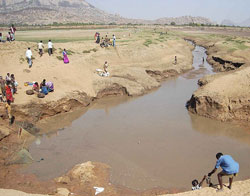 The theme of this year’s World Water Day on 22 March is ‘water and energy’ – giving a chance to reflect on how these two vital resources are linked. In the water sector, the food-energy-water nexus is slowly replacing the concept of Integrated Water Resources Management.
The theme of this year’s World Water Day on 22 March is ‘water and energy’ – giving a chance to reflect on how these two vital resources are linked. In the water sector, the food-energy-water nexus is slowly replacing the concept of Integrated Water Resources Management.
The idea of the nexus essentially gained momentum in the business community after the “food and energy crises” in 2007 and 2008. In a very paradoxical way, this was the first time that the business community, essentially through the World Economic Forum, came to realise the limits to growth.
The nexus is therefore about managing the relationship between food, water and energy security. Integrated water resource management was more land and ecosystem-led. Of course, there are different ways of managing this relationship, but a number of key actors, including The World Bank, World Economic Forum and most donors and international organisations have been looking at water storage as a site of control for managing food and energy needs. Storage is also seen as a way to manage water in the face of climate-related uncertainties.
We need plural systems and space for innovation
Considering the nexus of food, energy and water has helped dam building to come back to the forefront of the political agenda by focusing on water storage, and has driven a new STEPS centre project exploring dams as a pathway to sustainability.
Big dams were indeed sidelined for a few years following the recommendation of the World Commission on Dams, but are now seen as a ‘clean energy’ option within the green economy paradigm. However, storage solutions should not be limited to dam building: there is a diversity of pathways that exist. Natural wetlands, enhanced soil moisture, groundwater aquifers, ponds and tanks, or small dams or reservoirs; all these make the water storage continuum.
Many specialists, especially in International Water Management Institute, have proposed the idea of the continuum but it has never been applied to concrete projects. There is perhaps a need to move away in the policy world from multipurpose projects – which have largely failed – to multipurpose systems – and this idea of storage continuum.
The key problem is that aiming for optimal use and project conception does not allow space for more innovative solutions to take place. Dam optimization is about narrowing down to one single solution which does not allow for broad participation. While optimization may lead to one preferred solution, it also creates considerable risks. Diverse spontaneous policy solutions are needed to manage water in a time of risk and uncertainty.
Pathways to sustainability and a low-water economy
While the food-energy-water nexus needs to consider multiple solutions to storage systems, and while clumsy solutions may provide a risk mitigation strategy compared to optimization, would these provide the way forward to a pathway to sustainability? Given that there are underlying tensions between sustainability and growth, it is a time to reflect on the growth issue from a low economy water perspective.
As Ramaswamy R. Iyer, former Water Resources Secretary in the Government of India, stated at a recent JNU STEPS Symposium: “A ‘low water economy’ may mean a ‘water-efficient economy’ – up to a point. But beyond that it will have to mean a ‘low demand economy’ or a ‘low consumption economy.”
Overall, the nexus masks the bigger debate, which really lies around resource sustainability and growth. World Water Day 2014 provides a timely opportunity to reflect on the need for a ‘low water economy’.
By Jeremy Allouche, STEPS Dams project convenor. This article is reposted from the KNOTS team blog.
Photo: Talaparige at Cholenahalli, Tumkur district by indiawaterportal.org on Flickr (cc-by-nc-sa-2.0)